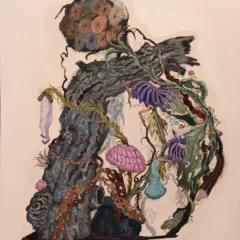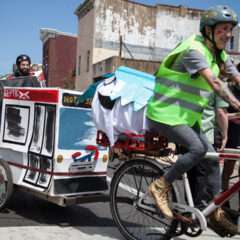[EDITOR’S NOTE: On Friday, Oct. 14, the PMA management negotiating team reached an agreement with the PMA union, and the union ratified the contract on Sunday, Oct. 16, upon a vote of its members that night. Hooray! And Congratulations, PMA Union!]
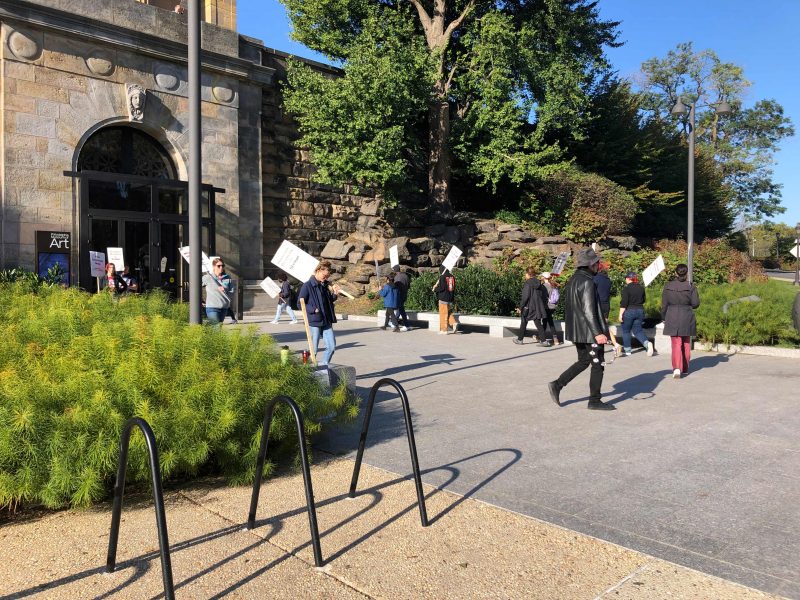
Julia writes
The year before the pandemic a google doc Arts + All Museums Salary Transparency 2019, started circulating among museum professionals as a means of highlighting the disparity in salaries of employees within and across institutions. Then the pandemic came and shook us all to the core. The questions of continued employment were front and center: what are we willing to do and still stay safe? Many were asked to make sacrifices to help employers stay afloat. While many were beginning to ask aloud how to stay sane under all these added pressures in the pandemic, but also in general. Unionization emerged as one way to protect the safety of workers.
On Tuesday Artblog went out to the Philadelphia Museum of Art to talk to workers on the picket line to see how they are doing, what’s the status of the strike and how they see things moving forward. I was taking photos at the main building, when I turned to step back and heard folks singing across the parkway and realized there were other sites of protest on the Museum grounds.
Those workers I talked to are hopeful. They say they are both “energized ad angry” and see the museum administration’s hardline strategy of not negotiating as a union busting move. Still, they believe the public is on their side. The fact that Philadelphia is a union town was made clear by all the cars and buses honking in support as we stood on the steps of the Perelman Building across from the main building. They also spoke to their dismay and disgust that the recently ensconced Director and CEO Sasha Suda has not until Wednesday acknowledged let alone met with the union leadership, despite saying to WHYY‘s Peter Crimmins that “she is looking forward to negotiating with the PMA union.” Suda also spoke with Crimmins about her plans to “invite all of Philadelphia to be part of … turning the institution inside-out, so that Philadelphia and the stakeholders for whom we exist, the communities that we long to be part of this community, can help us along, cheer us on, help build that momentum.” That is all very nice, and something you expect to hear from an incoming leader.
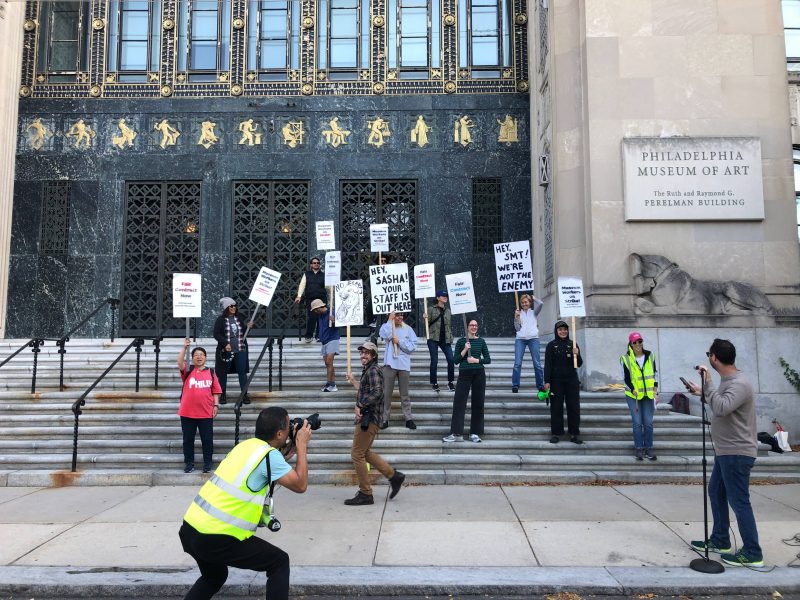
Yesterday, according to another post by Crimmins, at lunch for the press preview of the Matisse exhibition, Suda, who has been on the job 17 days, finally acknowledges the strike Wednesday. She has yet to meet with the union.
Hey… I get it. Being a newly hired executive director is hard no matter the scale. You feel buried. But people are the core of every organization, especially non-for-profits, which tend to rely on underpaid and under-resourced workers. Respect is something that doesn’t cost a dime. Just your time.
Those on strike expressed their concern for the collections, as the museum has moved to hire unskilled workers, namely preparators, essential to all exhibition installations, to hang the Matisse exhibit. Those I talked to also wanted the public to know they took pay cuts to help during the peak of Covid, cuts that were never restored. As one worker said on background, “We can’t pay the bills with prestige.”
I sent a message to the museum inviting them to comment on these questions: Where do negotiations stand? What is the museum’s strategy to resolve this strike? How is the museum taking care of the collections, while many of its most skilled workers are on the picket line? These were accompanied by the invitation to Ms. Suda to sit down for an interview.
I await their response. -Julia Marsh
Roberta writes
Julia Marsh, incoming Executive Director and Editor of Artblog (more on that coming up) and I went to the Philadelphia Museum of Art on Tuesday, Oct. 11, to listen to the voices of the workers who are on strike for better wages and benefits. The PMA Union is Local 397 of AFSCME District 4. Membership is around 200 and on Tuesday, Oct. 11, the strike was in its 16th day. As one worker put it, it was their 17th day without pay. I talked with workers from various departments – conservation, curatorial, installation – and found them unified in their desire to return to work after they’ve secured a fair contract. To a one, they all love their jobs. They all also spoke about being encouraged and empowered by the inter-departmental camaraderie that’s grown up on the picket line. We at Artblog are pro-union. More unions are better for workers and for society. We are flabbergasted that the museum management is dug into its strikebreaking stance. Salaries and benefits for workers must be fair for the work done. The PMA workers on strike are skilled workers and the museum needs to acknowledge their value to the institution with adequate pay and benefits. It is shameful to treat these workers as disposable and as if their service is not valued. The best way to help the PMA Union workers on strike (and today, Oct. 13, is their 19th day without pay) is to donate to the strike fund. –Roberta
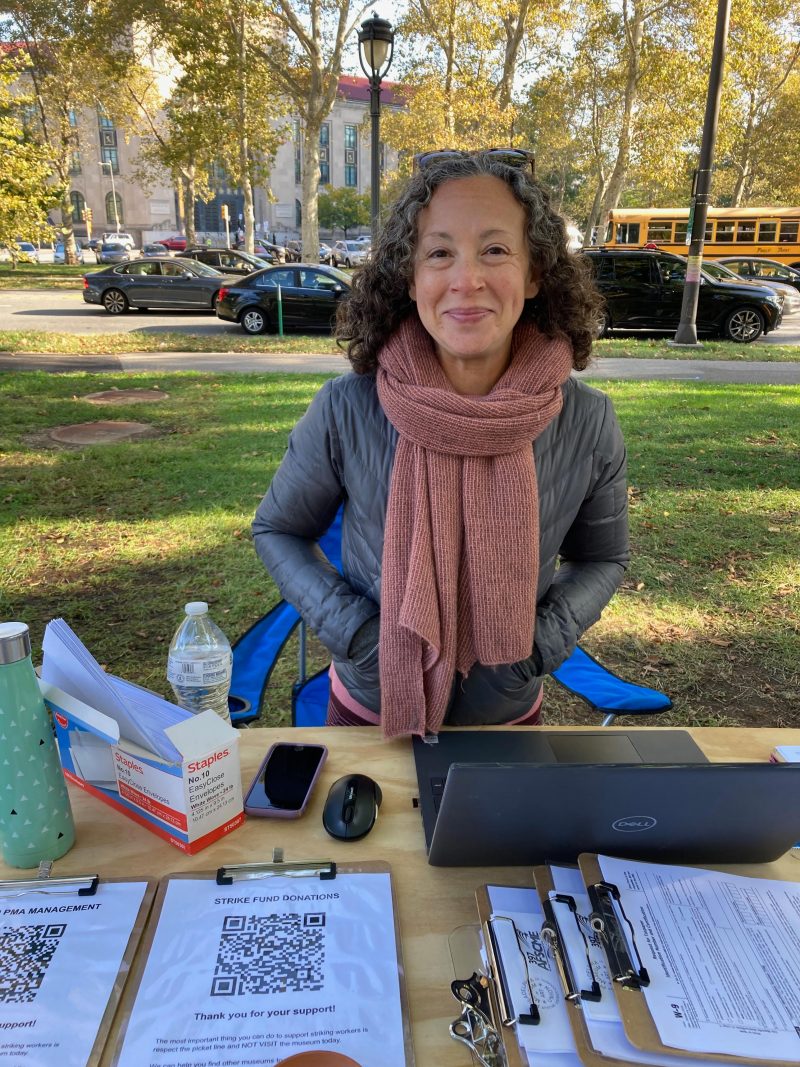
Below are the thoughts of Sarah Shaw, former PMA museum educator, now organizer with AFSCME District 47, who was out supporting the PMA Union workers on Tuesday when we were there. Following, are the words of four union members who were kind enough to share their thoughts.
Sarah Shaw
Former PMA museum educator. Her position was eliminated and she got a job working for District 47I am an Organizer with AFSCME District 47 supporting the workers who are out on strike.
In week 3, Day 16 today. This has been…this is the first action of this kind any of us have organized, participated in. Every day has been a little bit of a revelation for all of us I think, just witnessing the resolve and dedication and commitment of everyone to continue to come out here day after day to fight for what they deserve. Just witnessing the empowerment, the community care, the support for each other. From my perspective the message I would really like to get out there is that we get a lot of concern for the workers, seeing people out here in the rain and the wind and the cold, anger, frustration with the museum…all of those are totally valid responses. I think we’re feeling all of that too. To me, these museum workers really deserve to be celebrated; they deserve to be uplifted. It’s making a difference not only for them but for arts and culture workers in Philadelphia and all across the country. They are pioneers setting precedent for other groups of workers who might be more willing to take a risk in the future to improve their working conditions.Artblog – How far apart are the parties?
Sarah Shaw – Negotiations are ongoing. Things are moving; numbers are moving. Difficult to be precise about it. The short answer is not very far apart, on the order of a few hundred thousand dollars a year, which is such a small amount of money for an institution like this.
Art – How many years in the contract?
Sarah – It will be about a 3 year contract.
Anonymous Curatorial Department worker
This worker had been on the picket lines for 16 days. They were not furloughed and their position was not eliminated, but their pay was docked for a certain number of months during the pandemic.Artblog – What do you feel about this?
Curatorial – This is our 17th day without pay. Yeah, my resolve is strengthening. I am committed to being out here as long as we get a fair contract. I am repulsed by the museum’s behavior. It’s hard to imagine that these are our colleagues inside. I’m trying to resist the feeling of asking myself how I can ever work with these people again.Art – Will you go back (once a fair contract is reached)?
Curat – Yeah, I will. And frankly, my job is a job I love. It’s a dream position. I didn’t foresee the issues when I walked into the job but I am so amazed by my coworkers who are out here with me that I think we’re going to go back when we get a contract to work as a stronger group of people than we were before. I mean, I’m so much more in touch with people from across the institution being out here every day and I think we’re only going to carry that kind of strength and commitment back into our work. And we will make the place better for it. And it’s on senior management inside to do the work of repairing the relationships across the hierarchy.
Anonymous – Installations Department worker
This worker was furloughed for the pandemic for a year and then was brought back. They had been walking the picket line for 16 days.Artblog – How do you feel it’s going?
Installations – I feel it’s pretty wild. I was not fully into it at first and as things have gone further on it’s been really enjoyable to see all these departments get together, while we’re usually quite splintered and sectioned off from each other in various ways. It’s great! Everyone’s coming together, at least I feel like it. Better than about a week ago or more, I feel everyone’s got a little more fire in them and perhaps a little more positivity due to how much more public it’s getting.
Art – Do you want to go back once you get a contract?
Install – Yeah
Art – Are you confident you will get a contract?
Install – The longer the strike goes the more confident I am that it’s going to happen.
Art – You use the nails and puts on the white gloves and installs the art
Install – Yeah, and right now they have other people doing that for us.
Art – Have they crossed the picket line or are they sneaking in some other way?
Install – We have not laid eyes on them so they’re sneaking them in somehow or another. And there’s also people who work at the museum who are doing the hanging as well.
Art – How do you feel about that? About your museum coworkers working in there ?
Install – I never really had any expectation of anybody assisting us if they’re not in the union. They’re doing what they do and everyone has their reasons for doing what they do. I’m not going to point any fingers or shame anyone for it.
Anonymous – Installations and Packing Department worker
This worker was furloughed for a number of months at the start of the pandemic. They had been on the picket lines for 16 days.Artblog – How do you feel it’s going, both the picketing and also I understand negotiations are ongoing?
Installations and Packing – As far as I know the negotiations are stalled and they have been stalled. The museum wants us to lower our…what we want. And this is our first contract and that’s not going to work. I mean, we need to get above inflation as far as pay goes. So that’s 3 years without a raise (during the pandemic) and we’re losing money.
Art – It costs you to work here
Install and Pack – Laughs, Yes
Art – Once there’s a contract will you go back to work there?
Install and Pack – Yes absolutely.
Art – Do you like your job?
Install and Pack – I would say I love it.
Art – What did you install before the strike that you really loved?
Install and Pack – When we were brought back in after the pandemic, we were rushing to get ready for the openings, so there was the Martin Puryear over at the West Entrance outside of the Forum. I like that piece a lot. . I’ve started working more in the packing shop lately, so we’re getting ready, getting crates built for loans. Modiglianiis going to the Barnes, some Picasso and Braque works on paper going to…(I can’t remember).. Rodin sculptures going out on loan. Numerous things.
Art – Talk about the benefits issue.
Install and Pack – What we were asking for was parental leave. It was zero. They bargained for four weeks…it is out there. Health care? I actually don’t use it that much because it is costly.
Art – What’s the best way for people to support you?
Install and Pack – The best way is to donate to our strike fund and write to the COO, CEO, President of the Board Leslie Ann Miller. Those addresses are on the union website
Art – Were you here when Larry Krasner (Philadelphia’s District Attorney) came by?
Install and Pack – Actually missed that part! But, I thought that what he had to say was great. When workers are taken care of, it’s safer; when people are supported and get the things they need to live, then everything is safer.
Bernice – Conservation Department worker
Bernice had been out on the picket line for 16 days.Artblog – How do you feel it’s going from your perspective?
Bernice – I’m really uplifted to see all of my wonderful colleagues come together. I feel that we’re really united in our goal. And I’m disappointed that we’ve gotten to the 16 day mark.
Art – Others expressed how great it was to be united with workers from other departments
Bernice – I knew a lot of the people. But there’s certainly many who I’ve met since starting our pickets.
Art – What’s your job in conservation?
Bernice – I’m a textile conservator
Art – What’s the most exciting thing you ever worked on?
Bernice – (Laughs) Probably the most famous thing I worked on is Grace Kelly’s wedding dress.
Art – What did you do…what was the problem?
Bernice – In conservation we don’t only work on things that have problems; we prepare things safely for display or for travel. So, essentially I made it safe to go on display about 15 years ago for that exhibition.
Art – You’ve been here 15 years?
Bernice – I’ve been here 17 years.
Art – Where did you get your degree in conservation?
Bernice – I got my degree in the United Kingdom at the University of Southampton at the textile conservation center.
Art – How did you wind up in Philadelphia/
Bernice – I first came here on a year-long fellowship, and it was a very good fit and it turned into a permanent position. The Philadelphia Museum of Art is known worldwide within the conservation field as one of the leaders.
Art – Would you go back once there’s a contract?
Bernice – Yes, I will go back.
Art – How do you like Philadelphia?
Bernice – (Laughs) I love Philadelphia. I felt at home the moment I got here. I’ve made wonderful friends. It’s a welcoming city.
Art – Will things be ok in the conservation department (when the contract is reached and you’re back)? Did anyone not go on strike in the conservation department?
Bernice – The managers in the conservation department are not part of the bargaining unit so they did not go on strike.
Art – Is that going to be difficult when you go back?
Bernice – We’re a small department, and I’m really hopeful that we’re going to remain united in doing the good work that we’ve always done. So I think in Conservation we’re going to be fine.


